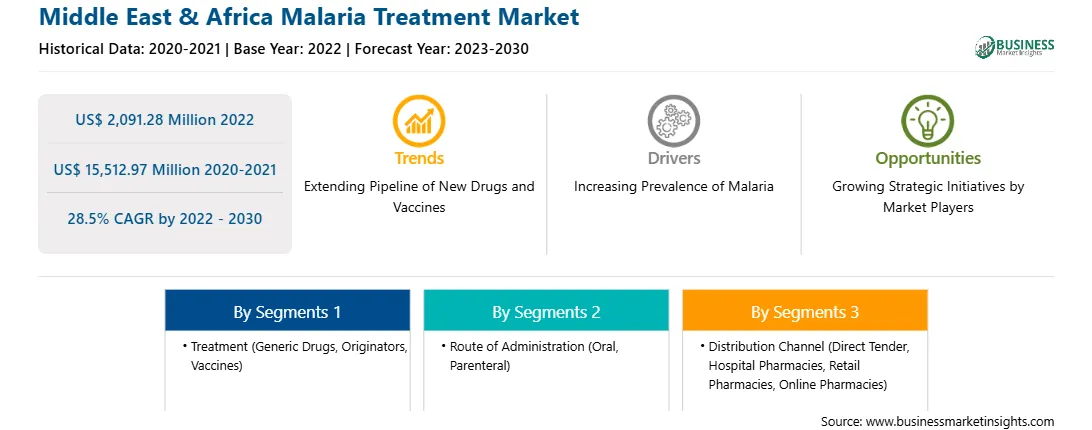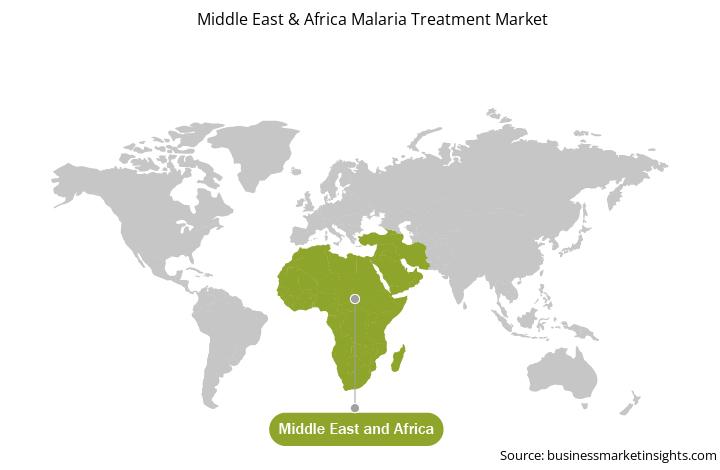The Middle East & Africa malaria treatment market was valued at US$ 2,091.28 million in 2022 and is expected to reach US$ 15,512.97 million by 2030; it is estimated to grow at a CAGR of 28.5% from 2022 to 2030.
Antimicrobial resistance can put the public at risk of many diseases, such as malaria. To overcome this challenge, the R&D of new medicines is considered the best strategy; as a result, the antimalarial pipeline is becoming increasingly robust. Public-private partnerships are accelerating research activities related to the treatment of malaria. For instance, Medicines for Malaria Venture (MMV), a nonprofit organization, works with numerous pharmaceutical companies to reduce the burden of malaria by developing novel treatment options. Therefore, the growing number of antimalarial and drugs/vaccines that are under clinical development are expected to boost the market growth in the future.
A few antimalarial that are under clinical development are mentioned in the table below:
Table 1. Malaria Drugs/Vaccine/Compounds Under Clinical Development
Drug Developer Clinical Trial Stage
Artefenomel Sanofi Phase IIb
KAE609 Novartis AG Phase IIb
KAF156 Novartis AG Phase IIb
DSM265 Takeda Pharmaceutical Company Phase IIa
SANARIA PfSPZ-GA1 Sanaria Phase II
SANARIA PfSPZ Vaccine - Radiation Attenuated PfSPZ Vaccine Sanaria Phase II
SANARIA PfSPZ-CVac Sanaria Phase II
MSP3-CRM-Vac4All Vac4All Phase I
Liver-Stage Antigen-3 (LSA3) Vac4All Phase IIa
Source: Company Website, The Insight Partners Analysis
Therefore, the growing number of antimalarial and drugs/vaccines that are under clinical development are expected to boost the market growth in the future.
The malaria treatment market in the Rest of Middle East & Africa is segmented into Israel, Iran, Iraq, Kuwait, Oman, Egypt, Quatar, and others. The Mediterranean Journal of Hematology and Infectious Diseases report states that imported malaria poses a serious health problem in Qatar. For example, imported malaria in Qatar increased during the past seven years despite the constant reduction, and the most affected were adult male migrants from endemic countries. Moreover, non-governmental organizations have stepped in to provide health education and preventative tools in countries where malaria is endemic. Furthermore, federal governments have also invested in commercials to educate the public on malaria transmission as well as methods of protection and treatment, which is likely to boost the market for malaria treatment in the Rest of Middle East & Africa.
Strategic insights for the Middle East & Africa Malaria Treatment provides data-driven analysis of the industry landscape, including current trends, key players, and regional nuances. These insights offer actionable recommendations, enabling readers to differentiate themselves from competitors by identifying untapped segments or developing unique value propositions. Leveraging data analytics, these insights help industry players anticipate the market shifts, whether investors, manufacturers, or other stakeholders. A future-oriented perspective is essential, helping stakeholders anticipate market shifts and position themselves for long-term success in this dynamic region. Ultimately, effective strategic insights empower readers to make informed decisions that drive profitability and achieve their business objectives within the market.

| Report Attribute | Details |
|---|---|
| Market size in 2022 | US$ 2,091.28 Million |
| Market Size by 2030 | US$ 15,512.97 Million |
| Global CAGR (2022 - 2030) | 28.5% |
| Historical Data | 2020-2021 |
| Forecast period | 2023-2030 |
| Segments Covered |
By Treatment
|
| Regions and Countries Covered | Middle East and Africa
|
| Market leaders and key company profiles |
The geographic scope of the Middle East & Africa Malaria Treatment refers to the specific areas in which a business operates and competes. Understanding local distinctions, such as diverse consumer preferences (e.g., demand for specific plug types or battery backup durations), varying economic conditions, and regulatory environments, is crucial for tailoring strategies to specific markets. Businesses can expand their reach by identifying underserved areas or adapting their offerings to meet local demands. A clear market focus allows for more effective resource allocation, targeted marketing campaigns, and better positioning against local competitors, ultimately driving growth in those targeted areas.

The Middle East & Africa malaria treatment market is segmented based on treatment, route of administration, distribution channel, and country. Based on treatment, the Middle East & Africa malaria treatment market is segmented into generic drugs, originators, vaccines, and others. The vaccines segment held the largest market share in 2022.
In terms of route of administration, the Middle East & Africa malaria treatment market is bifurcated into oral and parenteral. The oral segment held a larger market share in 2022.
By distribution channel, the Middle East & Africa malaria treatment market is segmented into direct tender, hospital pharmacies, retail pharmacies, online pharmacies, and others. The direct tender segment held the largest market share in 2022.
Based on country, the Middle East & Africa malaria treatment market is segmented into South Africa, Saudi Arabia, the UAE, Kenya, Tanzania, Rwanda, Nigeria, Ghana, Uganda, Angola, Cameroon, Senegal, Zambia, and the Rest of Middle East & Africa. The Rest of Middle East & Africa dominated the Middle East & Africa malaria treatment market share in 2022.
Cipla Ltd, Sun Pharmaceutical Industries Ltd, Sanofi SA, GSK Plc, Novartis AG, Pfizer Inc, and Lupin Ltd are some of the leading players operating in the Middle East & Africa malaria treatment market.
1. Cipla Ltd
2. Sun Pharmaceutical Industries Ltd
3. Sanofi SA
4. GSK Plc
5. Novartis AG
6. Pfizer Inc
7. Lupin Ltd
The Middle East & Africa Malaria Treatment Market is valued at US$ 2,091.28 Million in 2022, it is projected to reach US$ 15,512.97 Million by 2030.
As per our report Middle East & Africa Malaria Treatment Market, the market size is valued at US$ 2,091.28 Million in 2022, projecting it to reach US$ 15,512.97 Million by 2030. This translates to a CAGR of approximately 28.5% during the forecast period.
The Middle East & Africa Malaria Treatment Market report typically cover these key segments-
The historic period, base year, and forecast period can vary slightly depending on the specific market research report. However, for the Middle East & Africa Malaria Treatment Market report:
The Middle East & Africa Malaria Treatment Market is populated by several key players, each contributing to its growth and innovation. Some of the major players include:
The Middle East & Africa Malaria Treatment Market report is valuable for diverse stakeholders, including:
Essentially, anyone involved in or considering involvement in the Middle East & Africa Malaria Treatment Market value chain can benefit from the information contained in a comprehensive market report.